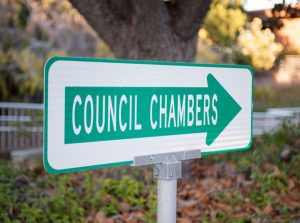Pomp and Circumstance
Awards and honors was the theme of the June 23 Santa Clara City Council meeting.
The 2015 Silicon Valley Power scholarships went to Santa Clara University student Manpreet Kaur, Cupertino High School graduate and Georgia Tech incoming freshman Shravan Sundaram and Santa Clara High School and UCLA incoming freshman Michelle Vo. High school and college students who are residents of Santa Clara, and studying to work in fields related to energy services, public power and the power industry are eligible to apply for the $5,000 scholarship.
Last month the City of Santa Clara received the International Institute of Municipal Clerks’ (IIMC) 2015 Program Excellence in Governance Award. Santa Clara was recognized for its 2014 Program to increase community engagement in the process of governance. This is the City’s third time receiving the award – the City has won the award every time it has applied.
The City also recognized outgoing commissioners: Andrew Kristalyn and Fran A. Palacio, Civil Service Commission; Kent Neal and Barbara Stahl, Cultural Commission; Jerry McKee, Historical & Landmarks Commission; Mike O’Halloran, Parks & Recreation Commission; Ian Champeny and Keith Stattenfield, Planning Commission; Frank E. Kadlecek, Senior Commission.
Former Santa Clara Council Member Kevin Moore was honored last week by the International Swim Hall of Fame for his efforts to find a new home for the historic museum in Santa Clara, a City that’s historically been synonymous with championship swimming.
Inclusionary “Affordable” Zoning Gets Boost From San Jose Court Win
The reason for the inclusion of “Informational Memo: Inclusionary Housing/California Building Industry Association vs. City of San Jose” on last week’s City Council agenda is something very important that’s talked about at every Council meeting in one way or another: affordable housing.
On June 15, the California Supreme Court rejected a California Building Industry Association (CBIA) challenge to San Jose’s 2010 inclusionary zoning law (requiring developers to set aside 15 of for-sale units for low and moderate income households at below market price in new residential developments with 20 or more homes).
The CBIA sued, saying San Jose’s ordinance was an unconstitutional “taking” of private property; relying on a 2009 case where the Court had found that requiring inclusionary set-asides of rental apartments, without a study demonstrating the “nexus” between the proposed project and the need for affordable housing, was unconstitutional. These “nexus” studies are costly, but have been customarily done as legal protections. The ruling was, as City Attorney Ren Nosky put it, “a shield against lawsuits.”
The Court ruled that the set-aside requirements – especially in the face of California’s acute affordable housing shortage – was a proper exercise of municipal power and wasn’t depriving developers of their property or the use of it, any more than any other zoning law.
Further, state law makes clear that planning appropriate and affordable housing is a city responsibility: “Local and state governments have a responsibility to use the powers vested in them to facilitate the improvement and development of housing to make adequate provision for the housing needs of all economic segments of the community.” (California Govt. Code 65580).
About 170 California cities have some affordable set-asides, and after this ruling there will probably be more. However, the ruling doesn’t apply to rental units, so it’s open to question whether the impact will be significant.
California leads the country in its shortage of affordable homes, and Santa Clara is fourth in the state, with a shortage of 67,576 affordable rentals, according to an April 2015 report by the state-created non-profit California Housing Partnership (CHP).
Shutting down California’s redevelopment agencies has only exacerbated a problem that is more than three decades old and worsening all the time. RDAs supplied 40 to 50 percent of California’s investment in affordable housing. Since the RDA shutdown, California’s investment in affordable housing has dropped from $2.5 million in 2008 to $750,000 in 2014, according to the CHP report.
Show of Support for 90 N. Winchester “Agrihood” Concept
Reportedly, there are about eight proposals for the six acres of open land remaining acres of open land at 90 N. Winchester – known familiarly as BAREC. However, nobody outside City officials have been given a peek at them, so we have no idea what offers are under consideration.
Although the project wasn’t on the agenda, last Tuesday about 50 people wearing yellow tee-shirts attended the City Council meeting to lobby visibly for one of those development alternatives – an “agrihood” built around shared green spaces that are working farms. It’s estimated there are about 200 agrihoods in the U.S., according to a recent New York Times story profiling Gilbert, Arizona’s Agritopia.
In 2006, Santa Clara’s Redevelopment Agency (RDA) purchased the six acres of the former UC agricultural research station on Winchester at below market price to build 165 affordable senior apartments with a one-acre garden area. Summerhill Homes bought the rest.
At that time the plan was that the non-profit Santa Clara Methodist Retirement Foundation-Catholic Charities (SCMRFCC) would partner to develop the project, with the City contributing $8 million of RDA housing funds for construction financing.
In 2012 RDA dissolution halted the project, as the County made the same grab for the Winchester property that it has for the Northside Library, the Convention Center and other City real estate. The State Department of Finance finally ruled that the land should properly go the City’s Housing Authority, but the County got the $8 million.
While 165 affordable senior apartments must be built, the entire six acres doesn’t have to be dedicated to that. Last February the Council agreed to entertain proposals for senior housing on part of the land and other development, including market rate housing, on the rest.
Information on the property and the project is on the City website at santaclaraca.gov and more information will be forthcoming, said City Officials.
Water Report: City Place Isn’t Going to Drain the City Dry
There are a few important takeaways from the two-inch thick Water Supply Assessment that was reviewed at the June 23 Council meeting. One is that Related’s City Place development won’t drain the City dry, as the City’s Chicken Littles would like us to fear. The entire development will only account for eight percent of City water use at most, and will make extensive use of recycled water – the Northside is already double-piped for recycled water use.
“More than 50 percent of the water we’re using is for lawns,” observed Mayor Jamie Matthews. “This is taking lawn out.” In addition, “the water used by the golf course percolates through the land fill and has to be treated. [Related’s project] will cap the landfill, so there won’t be any water flowing though it.”
Also, although the rumor has made the rounds, Santa Clara is unlikely to lose its share of Hetch Hetchy water. In fact, Hetch Hetchy is losing so many sales they’re having difficulty operating, according to Director of Water and Sewer Utilities Chris de Groot, Â and SC might become a permanent customer.











0 comments